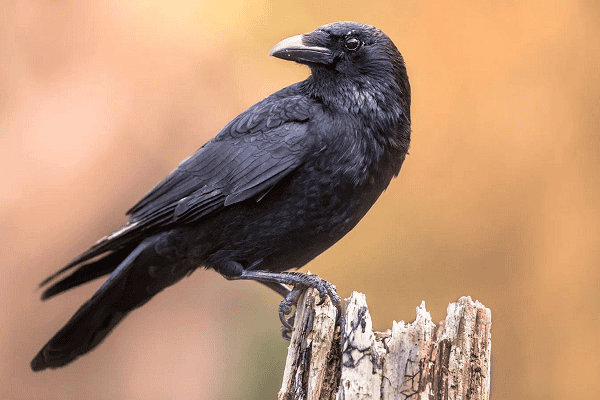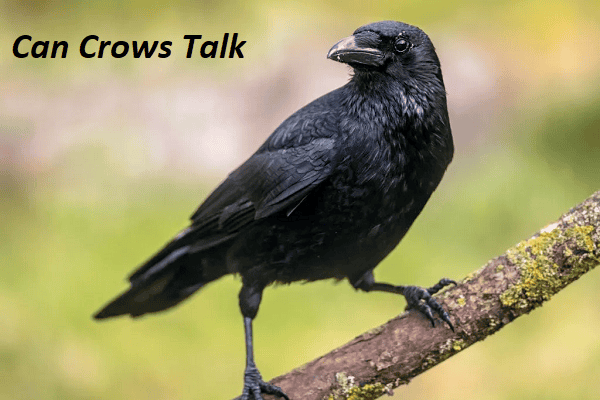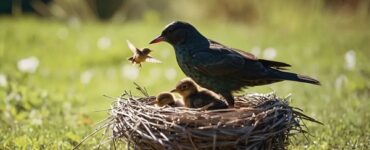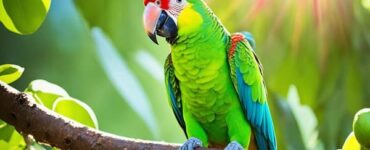In this article, we will explore the intriguing world of avian communication, specifically focusing on the ability of crows to talk. Join us as we dive deep into the fascinating behaviors and vocalizations of these intelligent birds.
Here we’ll learn about Can Crows Really Talk Like Human?
Understanding Avian Communication
Before we delve into the question of whether crows can talk, it is important to understand the broader context of avian communication. Birds, including the corvid, a group that includes both jays and crows, are known for their remarkable intelligence. family which includes crows, possess a fascinating language of their own. Let’s explore the various communication methods used by these intelligent creatures, including their unique vocalizations and language patterns.
Bird language, often referred to as “crow-speak,” is an intricate system of communication that allows birds to convey information and interact with each other. It involves a combination of vocalizations, body language, and even visual displays. Understanding the nuances of bird language is key to comprehending the intricacies of communication in crows and other avian species.

Crows, being part of the corvid family, are known for their sophisticated communication skills. Their speech patterns go beyond simple, random sounds. Researchers have identified distinct calls and vocalizations that serve specific purposes, such as warning of approaching threats, coordinating group movements, or even expressing their emotions.
Bird language extends beyond vocalizations. It also includes non-verbal cues like head movements, wing postures, and feather displays. These visual signals, when combined with vocalizations, create a holistic communication system that enables crows to convey a wide range of information effectively.
To fully grasp the complexity of communication in crows, it is essential to study their behavior within their natural habitats. Observing crows in the wild provides valuable insights into their social dynamics, group structures, and the role of communication in maintaining cohesive relationships within a flock. It also highlights the adaptive nature of their communication strategies, particularly when faced with various environmental challenges.
With the advancement of technology and scientific research, we have gained a deeper understanding of crow communication. Studies have revealed fascinating findings, shedding light on the intricacies of crow speech patterns and their transcript analysis, showing how these birds can repeat and modify sounds. and their significance in establishing social hierarchies, identifying individuals, and even recognizing familiar humans.
As we continue to explore avian communication, the language of crows unveils the remarkable complexity of their social and communicative abilities. By studying the communication methods employed by these fascinating creatures, we can gain valuable insights into the broader field of intelligent bird communication and its role in their natural ecosystems, highlighting the adaptability and intelligence of jays and crows.
The Speech-Like Behavior of Crows
Crows exhibit intriguing behavior that resembles speech, often mimicking human words and sounds, like saying These remarkable observations have sparked curiosity and led to studies exploring the intelligence behind these abilities. Let’s delve into the fascinating world of crow speech patterns and their ability to imitate human speech.
Fascinating Observations of Talking Crow Behavior
Over the years, researchers and bird enthusiasts have documented instances of crows imitating human words and sounds. These mimicking abilities have been observed both in the wild and in captivity, showcasing the adaptability and intelligence of these birds, as well as parrots.
A notable case is “Canuck,” a captive crow at the Cincinnati Zoo in the 1980s. Canuck fascinated visitors with its ability to say mimic various sounds, including human speech. This anecdote highlights the astonishing mimicry skills possessed by certain crows.
The Intelligence Behind Crow Speech Patterns
What drives crows to imitate human speech? Studies suggest that intelligent birds like crows possess complex vocal learning abilities. They can mimic and modify sounds, creating a diverse repertoire of vocalizations for a flock of crows.
Researchers have analyzed the vocalizations of crows to identify patterns and understand their communication system, highlighting how can crows talk. By studying the neural mechanisms involved in crow speech, scientists hope to uncover the underlying intelligence and cognitive processes at work.
Crow Speech Studies and Findings
Several studies have shed light on crow speech patterns and their ability to mimic human speech. Researchers have used audio and video recordings to analyze the vocalizations of these fascinating birds.
For instance, a study published in the journal showcased how crows are very smart, capable of using tools and solving complex problems. Journal of Comparative Psychology documented the vocalizations of wild crows and their ability to imitate novel sounds, including human speech. The findings demonstrated the flexibility and ingenuity of crow communication, hinting at how crows are very smart and capable of complex vocal mimicry.
| Study | Key Findings in the study of crow’s vocalizations and their ability to communicate. |
|---|---|
| “The Mimicry Abilities of Crows” | Crows in captivity can mimic complex sounds, including human speech. |
| “Vocal Learning in Wild Crows” | Wild crows exhibit the ability to imitate novel sounds, showcasing their adaptability and proving that crows are amazing in their vocal mimicry skills. |
| “Neural Mechanisms Underlying Crow Speech” | Research on crow brains reveals complex neural pathways involved in vocal learning and speech-like behavior. |
Through these studies, researchers have gained valuable insights into the speech-like behavior of crows, highlighting their impressive cognitive abilities and communication skills.
The Science Behind Crow Communication
Scientific research and observations have provided us with valuable insights into how crows communicate. These highly intelligent birds, belonging to the corvid family, employ a variety of vocalizations and behaviors to convey messages within their flock and even interact with humans.
As members of the Corvidae family, crows have long been recognized for their ability to communicate effectively. Their vocalizations range from loud caws to more subtle calls and intricate patterns. By studying these-corvid vocalizations, researchers have unraveled the complexity of crow communication.
One intriguing aspect of crow communication is their remarkable ability to mimic other sounds. While primarily known for mimicking the calls of other birds or animals in the wild, crows have been observed mimicking human speech as well. This mimicry further highlights their intelligence and adaptability.
Wild Flock Dynamics:
In the wild, crows gather in flocks which can range in size from a few individuals to massive gatherings of hundreds or even thousands of birds. Within these flocks, crows communicate through a combination of vocalizations and body language to coordinate their movements and warn each other of potential dangers.
Table: Crow Vocalizations in the Wild
| Vocalization | Description |
|---|---|
| Caw | A loud, distinctive call that is used for a variety of purposes, including territory defense and group cohesion. |
| Alarm Call | A quick, sharp call is used to warn other crows of potential threats or predators in the area. |
| Territorial Call | A repetitive call was used to establish and defend territory boundaries. |
| Contact Call | A soft, low-frequency call used to maintain contact between flock members. |
Interactions with Humans:
Not only do crows communicate within their species, but they also possess the remarkable ability to interact with humans. Some crows have been known to recognize specific individuals and respond to human gestures and speech. This unique bond between crows and humans offers an opportunity for further study on the intricacies of cross-species communication.
Table: Crow-Human Interactions
| Interaction | Description |
|---|---|
| Speech Recognition | Crows have demonstrated the ability to recognize and mimic human speech, showcasing that crows can talk. respond to human speech, sometimes even imitating words or sounds. |
| Response to Gestures | Crows can interpret and respond to human gestures, such as offering food or using tools. |
| Problem-Solving Cooperation | When presented with complex tasks, crows have been observed collaborating with humans to find solutions. |
Through ongoing research and observation, we continue to expand our understanding of crow communication. By uncovering the intricacies of their vocalizations, flock dynamics, and interactions with humans, we gain deeper insights into the remarkable intelligence of these captivating birds.
Can Crows Talk: A Closer Look at Vocal Mimicry in Crows
Crows are known for their remarkable vocal mimicry abilities, displaying a wide range of sounds in their repertoire. One of the most intriguing aspects of their mimicry skills is their ability to imitate human speech. Just like parrots, crows have shown an intelligent capacity to mimic the speech and voice of humans.
Research has shown that crows can mimic not only specific words and sounds but also the cadence and tone of human speech. This mimicry behavior has led scientists to explore the similarities between the vocal capabilities of crows and other intelligent birds like parrots.
Both crows and parrots can mimic human speech, showcasing their impressive intelligence and adaptability. Although they have different vocal mechanisms, both species have demonstrated the capacity to accurately replicate the sounds they hear from their environment, mimicking various human expressions and patterns of speech.
Similarities between Crows and Parrots in Vocal Mimicry
While crows and parrots may be different in many ways, there are several notable similarities between their mimicry abilities:
| Crows | Parrots |
|---|---|
| Crows communicate through a complex range of vocalizations and can mimic various sounds, including mimicking human speech. | Parrots also use diverse vocalizations for communication and have the remarkable ability to mimic human speech and other sounds. |
| Crows have been observed imitating the calls of other bird species as well as the sounds of animals and even mechanical noises, almost like a repeating record of their environment. | Parrots can mimic a wide variety of sounds, including the calls of other bird species, musical tunes, and human speech. |
| They demonstrate a high level of auditory learning and can accurately reproduce the sounds they hear in their environment. | Parrots possess exceptional auditory learning capabilities, allowing them to mimic and replicate complex sounds with precision. |
These similarities highlight the intelligence and adaptability of both crows and parrots in imitating and mimicking various sounds, including human speech. It suggests that vocal mimicry might serve similar functions in their communication systems, allowing them to better adapt and integrate into their social and ecological environments.
Further research on vocal mimicry in birds, particularly in crows and parrots, can provide valuable insights into the complex nature of communication in the avian world. By studying their remarkable abilities, we can gain a better understanding of how these intelligent creatures interact with their surroundings and each other.
The Role of Crows in Human Interaction
Human-crow interactions have provided fascinating insights into the communication dynamics between these intelligent birds and humans. Crows have demonstrated their ability to respond to human speech and gestures, highlighting their remarkable intelligence and adaptability in communication.
Studies and observations have revealed instances where crows not only recognize human voices but also respond in specific ways. They can differentiate between friendly and threatening tones, indicating a level of comprehension beyond mere vocal recognition.
Research has shown that crows are highly perceptive of human body language as well. They understand and react to human gestures and movements, displaying an astute awareness of their surroundings and the intentions of the individuals they encounter. This ability to interpret and respond to non-verbal cues further illustrates the sophisticated communication skills of these avian species, almost like they’re saying hi without words.
Crows also engage in vocal exchanges with humans, responding to calls, whistles, or even specific words. These interactions suggest a level of reciprocal communication that goes beyond the boundaries of traditional human-animal communication.
Furthermore, crows have been observed to establish lasting associations with individual humans. They recognize and remember faces, forming unique relationships based on trust and mutual understanding. In some cases, crows have been known to bring gifts or offer tokens of appreciation to their human counterparts, further exemplifying the depth of their communication abilities.
The complex and nuanced nature of human-crow interactions challenges our understanding of communication, blurring the line between the human and animal realms. These intelligent birds continue to surprise and captivate us with their exceptional abilities, reminding us of the rich tapestry of communication that exists in the natural world.
The Phenomenon of Crow Speech in Captivity
Crows held in captivity have captivated researchers with their remarkable ability to imitate words and sounds through training. These intelligent birds have proven themselves to be quick learners and adapt well to their environment.
One of the reasons crows are regarded as one of the smartest birds is their ability to learn and repeat human language, evidencing their advanced cognitive abilities. vocalization abilities. In captivity, they have been known to imitate a wide range of sounds, including human speech, demonstrating their exceptional mimicry skills.
The training methods used to teach crows how to modify sounds, creating a diverse repertoire of vocalizations, a skill often showcased in YouTube videos, including their attempts to imitate sounds are a combination of positive reinforcement and repetition. By rewarding the crows with treats and praise when they successfully imitate a sound, trainers create a positive association that encourages them to continue imitating.
It’s important to note that not every crow can imitate sounds with the same proficiency. Just like humans, some individuals may display a higher aptitude for mimicry than others. Understanding this individual variation is crucial when training crows.
The implications of crow speech in captivity are significant. It not only provides a deeper understanding of avian communication but also opens up possibilities for studying vocal learning and cognitive abilities in birds. By studying trained crows, researchers can gain insights into the mechanisms behind vocalization imitation and cognitive processes.
The phenomenon of crow speech in captivity sheds light on the incredible intelligence and adaptability of these birds. It reaffirms their position as one of the intelligent species, akin to ravens and parrots. smartest bird species and highlights the potential for further research in avian communication and vocal learning, especially concerning jays and crows.
Training Method involving crows and ravens for Crow Speech
Trainers employ various methods to teach crows how to imitate sounds. Here are some common techniques used:
| Training Method | Description |
|---|---|
| Positive Reinforcement | Rewards, such as treats and praise, are given to crows when they successfully imitate a sound, reinforcing the desired behavior. |
| Target Training | Trainers use a target object or specific cue to associate it with the desired sound, helping the crow understand the task. |
| Vocal Modeling | Trainers play recordings of the desired sounds, encouraging the crows to mimic the vocalizations they hear. |
| Progressive Learning | Trainers start with simple sounds and gradually increase the complexity of the imitations, building upon the crows’ abilities. |
These training methods, when applied with patience and consistency, can unlock the vocalization potential of crows and provide invaluable insights into their communication capabilities.
Final Thoughts on Can Crows Talk
In conclusion, the natural vocalizations and communication patterns exhibited by Corvidae, such as crows, highlight the remarkable level of intelligent bird communication in the avian world. While they may not possess the ability to talk like humans do, crows have an intricate language that serves various purposes within their societies.
Studying and understanding avian communication, including the unique vocalizations and behaviors of Corvidae, can provide valuable insights into the natural world. By unraveling the secrets of intelligent bird communication, we can gain a deeper appreciation for the complexity and diversity of animal languages.
As we continue to delve into the fascinating realm of avian communication, our understanding of the natural world expands. From the rich vocal mimicry abilities of crows to the intricate communication systems they utilize in the wild, these intelligent birds invite us to explore the depths of their language and their unique place in the animal kingdom.
Check Our Previous Articles
| Orange and Black Birds in Colorado |
| How To Get Kids Interested In Birdwatching? |
| Doves In Arizona |
| Blue Birds in Michigan |
Frequently Asked Questions About Can Crows Talk Like Parrots
Q1. Can crows imitate their voice?
No, crows generally do not imitate their voices.
Q2. Can crows talk and understand us?
Crows have demonstrated some ability to understand human behavior and communicate with us.
Q3. How intelligent are crows?
Crows are highly intelligent birds, capable of problem-solving and learning complex tasks.
Q4. Are crows and ravens the same?
No, crows and ravens are different species of birds, although they are both members of the corvid family.





Add comment